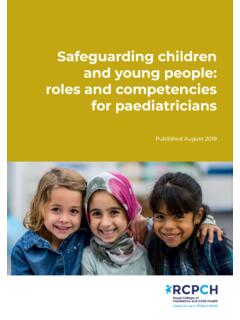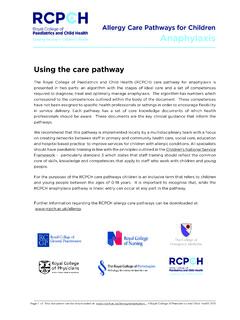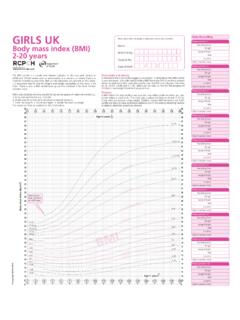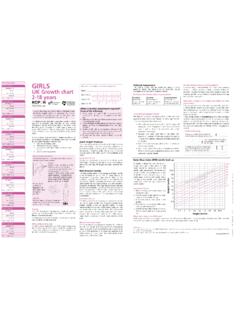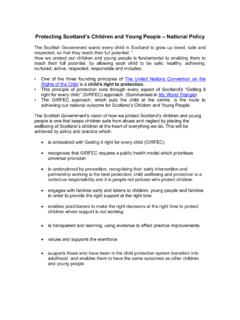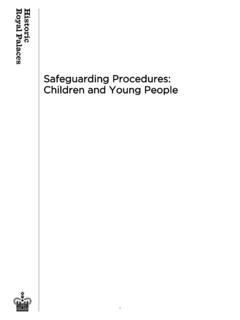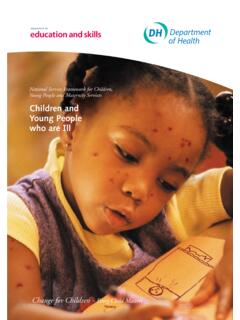Transcription of for Children and Young People in Emergency Care Settings ...
1 Royal College of Paediatrics and Child Health5-11 Theobalds Road, London, WC1X 8 SHThe Royal College of Paediatrics and Child Health (RCPCH) is a registered charity in England and Wales (1057744) and in Scotland (SC038299).Standards for Children and Young People in Emergency Care Settings Standards for Children and Young People in Emergency Care SettingsDeveloped by the Intercollegiate Committee for Standards for Children and Young People in Emergency Care SettingsBritish Association of Paediatric SurgeonsCollege of Emergency MedicineJoint Royal Colleges Ambulance Liaison CommitteeRoyal College of AnaesthetistsRoyal College of General PractitionersRoyal College of NursingRoyal College of Paediatrics and Child HealthStandards for Children and Young People in Emergency Care Settings2012 Developed by the Intercollegiate Committee for Standards for Children and Young People in Emergency Care SettingsRepresentative bodies.
2 British Association of Paediatric SurgeonsCollege of Emergency Medicine Joint Royal Colleges Ambulance Liaison CommitteeRoyal College of Anaesthetists Royal College of General PractitionersRoyal College of NursingRoyal College of Paediatrics and Child HealthA web version of this document is available through Royal College of Paediatrics and Child Health 2012 for Children and Young People in Emergency Care Settings1 Contents Foreword ..2 Executive summary ..31. Purpose and scope of this document ..8 2. Current challenges facing paediatric Emergency care ..93. Service design: an integrated urgent care system ..104. Environment in Emergency care Settings ..145. Management of the sick and injured child.
3 176. Staffing and training issues ..207. Safeguarding in Emergency care Settings ..278. Mental health, substance and alcohol misuse ..309. Major incidents involving Children or Young People ..3310. Death of a child ..3511. Information systems and data analysis ..38 Appendices ..41 Abbreviations ..41 Equipment list for Emergency care Settings ..42 Paediatric resuscitation training and updating ..45 Terms of reference and membership of the Intercollegiate Committee for Standards for Children and Young People in Emergency Care Settings ..47 References ..48 Standards for Children and Young People in Emergency Care Settings2 ForewordChildren and Young People deserve the highest standards of care1.
4 Since the original Accident and Emergency Services for Children was published in 1999 and updated in 2007 there have been significant changes to urgent care health provision in the UK. Care is now provided in minor injury units, walk in centres and pharmacies as well as Emergency departments. Paediatric Emergency medicine has continued to evolve and is now a recognised sub-specialty for training from both Emergency medicine and paediatrics. The Intercollegiate Committee for Standards for Children and Young People in Emergency Care Settings has remained active since its inception in 1999. It sits within the committee structure of the Royal College of Paediatrics and Child Health (RCPCH).
5 It has been responsible for developing a number of guidance and standards documents2345 relating to all aspects of Emergency and urgent care for Children and Young People . Challenges still exist; ever increasing attendances at Emergency and urgent care Settings , the impact of the European Working Time Directive (EWTD) on availability of staff and increased public expectation of immediate access to care all require service planners to take a renewed approach to Emergency healthcare. The original publication was widely used in the UK to improve the care of Children in Emergency Settings . This third edition of the 1999 guidance has been renamed Standards for Children and Young People in Emergency Care Settings and has incorporated chapters specifically related to Young People and mental health, together with consolidating others towards a more pathway approach.
6 The committee members commend this publication to you and hope you find the standards practical, useful and Stephanie Smith BMBS FRCPCH MRCP Consultant in Paediatric Accident and Emergency MedicineChair, Intercollegiate Committee for Standards for Children and Young People in Emergency Care Settings20123 Standards for Children and Young People in Emergency Care SettingsStandardPageService design: an integrated urgent care system1. All staff delivering urgent care to Children are competent in the basic skills required for safe practice, in whichever setting they work2. Service planners, commissioners and providers work together to provide safe urgent care for Children in a geographical network, taking local needs into account3. Healthcare organisations encourage shared or rotational posts, or regular secondments to the acute unit4.
7 Emergency departments work with local community providers to develop care pathways for common conditions to facilitate care closer to home5. The Urgent and Emergency Care Clinical Audit Toolkit is used to review individual clinician consultations systematically wherever Children with urgent care needs are assessed, including on the telephone, face to face, in hospital or in the community6. Regional critical care networks are in place to develop protocols to stabilise and transfer Children to specialist centres10-13 Environment in Emergency care settings1. Emergency care Settings accommodate the needs of Children , Young People and accompanying families and comply with DH You re Welcome and HBN 22 standards2. As well as audio-visual separation from adults, consideration is given to security issues, availability of food and drink, breast-feeding areas, and hygienic, safe play facilities3.
8 At least one clinical cubicle or trolley space for every 5,000 annual child attendances is dedicated to children4. Young People have access to quieter waiting and treatment areas, and age-appropriate games, music or films5. Emergency departments seeing more than 16,000 Children per year employ play specialists at peak times or have access to a play specialist service6. Participation is encouraged by Children , Young People , siblings, parents and carers regarding on going quality and improvement of services or facilities14-16 Executive Summary Complete list of standards for Children and Young People in Emergency care settingsStandards for Children and Young People in Emergency Care Settings4 Management of the sick or injured child1. All facilities receiving sick or injured Children are equipped with an appropriate range of drugs and equipment (appendix 2)2.
9 All Children attending Emergency care Settings are visually assessed by a registered practitioner immediately upon arrival, to identify an unresponsive or critically ill/injured child3. An initial clinical assessment occurs within 15 minutes of arrival4. A system of prioritisation for full assessment is in place if the waiting time exceeds 15 minutes5. Initial assessment includes a pain score6. Analgesia is dispensed for moderate and severe pain within 20 minutes of arrival7. Individualised management plans are accessible for Children who attend the Emergency care setting with priority access Emergency passport/card holder 8. Systems are in place to ensure safe discharge of Children or Young People , including advice to families on when and where to access further care if necessary9.
10 All urgent care attendances in Children and Young People are notified to the primary care team: ideally both the GP and the health visitor/school nurse17-195 Standards for Children and Young People in Emergency Care SettingsStaffing and training1. Nurses working in Emergency care Settings in which Children are seen require a minimum level of knowledge, skills and competence in both Emergency nursing skills and in the care of Children and Young people2. Acute healthcare providers facilitate additional training in paediatric skills for the nursing staff in the Emergency department, and have a long-term strategy for recruitment and retention of registered Children s nurses3. All clinical staff working in Emergency Settings have a minimum level of knowledge, skills and competence in caring for Children and Young People , recognition of serious illness, basic life support, pain assessment, and identification of vulnerable patients4.
